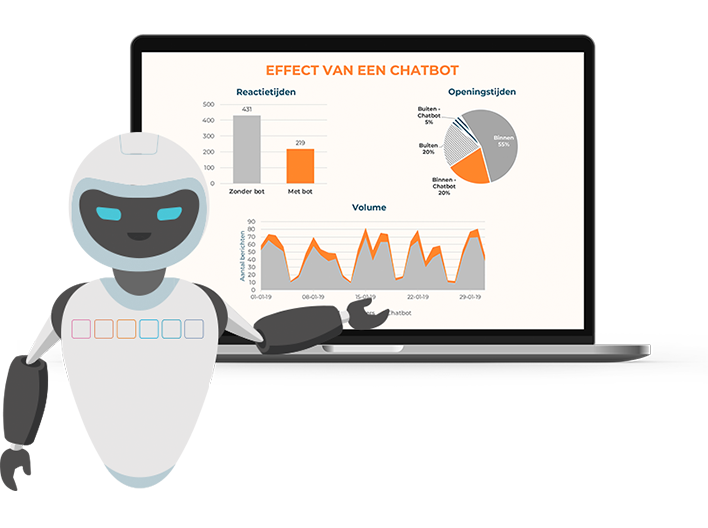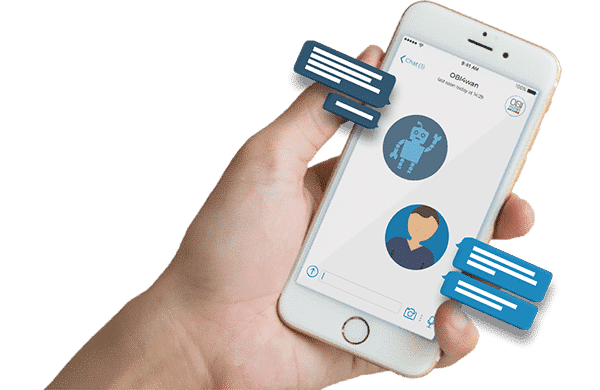5 tips for insurance companies considering a chatbot

The end of the year is approaching — the time for consumers to take a closer look at their insurance policies. For health insurance specifically, switching over can only be done in November and December. The enormous peak-load on customer service at the end of the year therefore never comes entirely unexpected. In addition to the deployment of additional employees, A.I. (artificial intelligence) can also be a good solution. With the help of chatbots, it’s easier to help quickly and easily so that customer service representatives can devote their time to more complex questions. Earlier on, we spoke with Aon and Univé about their considerations and experiences when they started using chatbots. We‘ve used their experiences to compile 5 tips when using chatbots.
1. Determine whether a chatbot is interesting
As an insurance company, it can be interesting to say the least, getting started with chatbots, but it’s also very important to have a good understanding, in advance, of what a chatbot can actually mean for your organisation. A good starting point is to determine, on the basis of a data analysis, to what extent a chatbot can be used for the type of customer service that your organisation offers.
To get that kind of insight, you can have a Feasibility report done on your customer service’s historical data, for example. This type of analysis report not only provides insight into reaction times and peak moments, but also how and where a chatbot can support you best with regard to this. This way, you know in advance whether a chatbot is going to be profitable for your organisation.

Univé got started themselves with working on a Feasibility report. The analysis showed that the chatbot could answer an estimated 12.8% of the total messages, and that a bot could ensure faster response times, even outside of office hours. That was decisive for Univé. Mathijs Jilderda, Customer Experience advisor at Univé explains:
“The report gives us a nice and clear overview, in facts and figures. It also goes, very concretely, into the advantages of what a chatbot would mean for us. Thanks to the analysis, we also gained valuable insight into the number of messages a chatbot can receive and what types of questions are most suitable for the chatbot.”
2. How do you achieve the greatest efficiency boost?
For the greatest efficiency boost, it’s important to focus on the types of questions that have the most volume and once you have identified them, assess whether or not they can be easily recognised and answered by a chatbot. Questions regarding a new health insurance card or reimbursements are fairly easy for a chatbot to answer. But questions about personal damage or an incorrect invoice are many times too specific for a chatbot. The trick is to use chatbots for the more standard questions, so that employees can be available to answer the more complex customer questions.
A chatbot can also be used to do a lot of the prep-work, for example, where the chatbot can ask the customer to share certain information in advance. This helps in being able to help the customer more quickly once they’ve been transferred to an actual employee. In any case, make sure that a customer can always go from a chabot directly to an employee, during opening hours. This prevents any irritations from arising in case the conversation doesn’t go as smoothly as planned. The handover from chatbot to an employee needs to be extremely clear for the customer, so that he or she knows exactly what to expect.
Another big advantage is that chatbots can work outside regular opening hours and can therefore handle any standard questions that come up. At Univé even 15% of the chatbot conversations are conducted outside opening hours.
3. Build a chatbot yourself or outsource?
Are you, like Univé, at once enthusiastic about the added value of a chatbot? Then you have the choice to get started yourself or to outsource the entire process. If you choose to build a chatbot yourself, you also build and write the conversations yourself using a chatbot platform. Due to technological developments, programming knowledge is usually not necessary for this. An organisation that took the plunge is Aon. Jasper Meijerink of Aon explains:
“Before we knew it, we had built a full prototype of our first chatbot, all by ourselves. The whole process went very smoothly and you really don’t need any programming knowledge. Our developers are very enthusiastic about the platform and especially enjoy building the chatbots themselves.”
Invaluable input from your own employees regarding chatbot development
If, as an organisation, you’re going to get to work on a chatbot yourself, make sure you get good input from the customer service employees and the marketing communications department. After all, they’re the ones who have daily contact with customers and know exactly what questions are being asked and in what tone they communicate. Jasper adds:
“The input from the marketing and communications department is indispensable throughout the entire process. It’s also great that our developers have a background as call centre employees. They know exactly who our customers are and how best to communicate with them. That came in very handy during the chatbot’s development process.”
4. Knowledge is power
Once the chatbot is operational, make sure that the results are transparent. Don’t just look at the quantitative results, such as the number of questions captured and the response time, but also keep a close eye on customer satisfaction and the NPS. Research by Accenture among 25,000 consumers from 33 countries shows that if good service is not provided, 61% of consumers will switch to a competitor.
5. Regularly refine the chatbot
It‘s important to keep optimising the chatbot, because you also continuously improve your services. At Aon, they train the chatbot with the data they receive daily through both the chatbot and the live chat. That is an ongoing optimisation process. The use of artificial intelligence makes the chatbot a little smarter every day and able to answer increasingly complex questions.
At Univé, they also test whether the chatbot responds correctly and make adjustments if necessary. But remember: think big, act small. Let a chatbot first perform one specific task properly before you assign it other, tasks. This way you stay in control and you can determine what the next step will be.

Chatbot or not, the customer wants to be well-served, and to get quick answers to his or her questions. For the customer service of insurance companies, and in particular, of health insurance, the last two months of the year are the months where all the difference can be made.
Curious about the effect of chatbots on your organisation?
Request a feasibility report. With the help of this analysis you will quickly discover the benefits chatbots can offer and gain insight into what a chatbot can mean for your organisation.